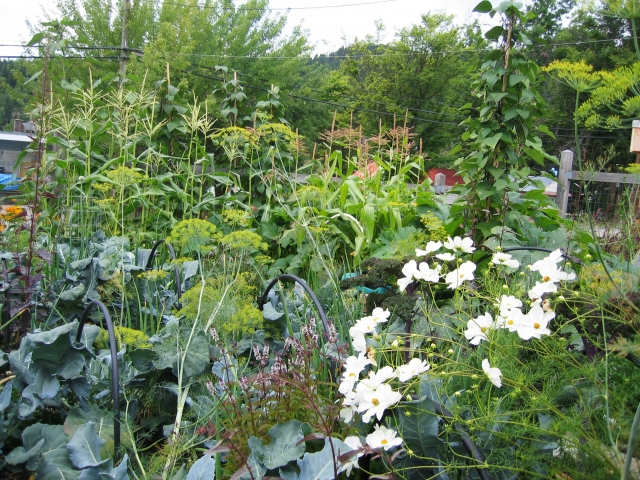OPINION: Food Fights in our Future?
Food from “away”:
It’s becoming common knowledge that most of the food we eat here in BC comes from other places: rice from Asia or California, oranges and orange juice from Florida, Texas or California, vegetables and almonds mostly from California, wheat and other grains from the prairies, and convenience foods — prepared and packaged for us — come from many places around the globe: Korea, Thailand, Italy, England, Brazil and other South American countries, various places in the United States, China, Poland, and so on.
How certain are we that we can continue to have access to foods “from away” indefinitely? Aside from potential interruptions in transportation because of increasing extreme weather events, there are other reasons to wonder.
Droughts and disease
More people are becoming aware that droughts in California are reducing food production there, from fruits and vegetables to nuts — many of us have seen pictures of drought-stricken almond orchards being uprooted — and all of us have noticed price increases (famously, $9 cauliflowers) caused by scarcer crops as well as the weaker Canadian dollar. We’ve heard that citrus fruit production in Florida and Brazil is plummeting because of an Asian insect, the Asian citrus psyllid, and the disease it spreads, known as “citrus greening.” The insect was first found in Florida in 2005, and since then, citrus production has dropped by 82%, according to a November 1915 article in Bloomberg Business. Citrus greening is not the only factor limiting citrus production: urban sprawl and unusual weather events linked to climate change are also having an effect.
What about Fisheries?
Fisheries may not seem very important to inland dwellers, but over 540 million people in the world depend on fish for their dietary protein. Overfishing and climate change have both been cutting into oceanic supplies of marine species. The National Oceanic and Atmospheric Administration of the United States (NOAA), and the and the Fisheries and Aquaculture Department of the Food and Agriculture Organization of the United Nations both have a number of reports on the topic on their websites: respectively,
http://www.fisheries.noaa.gov/stories/2014/03/climate_portal.html and
http://www.fao.org/fishery/climatechange/en
Crops and Climate Change
Climate change is expected to reduce global food production significantly. Economists from Stanford University and the Massachusetts Institute of Technology have studied the potential for trade to alleviate problems of diminished agricultural production and issued a report suggesting that trade will not help much — but rather “that countries will have to alter their own patterns of crop production to lessen farming problems.”
The study bases its projections on the IPCC (International Panel on Climate Change) information. It estimates potential agricultural losses globally and for certain countries, and notes that losses will vary a great deal from place to place. But, while global population is predicted to continue to rise, global food production could fall by one-sixth — or more. Changing weather and temperature patterns and extreme weather events are among the contributing factors.
IPCC information is considered by some climate scientists to be out-of-date and overly optimistic; some information was simply not considered in the IPCC report, such as the potential contribution of greatly accelerated ice-sheet melting to sea level rise. There is a discussion of the IPCC report and the accuracy of its statements in Wikipedia, here.
Eating Local Food?
Growing more food in city yards and encouraging agriculture to flourish locally can only be a good thing, right? Food is fresher and more often organically grown; less fossil fuel is used in transporting it; it contributes more to the local economy.
But how much of its population can a city feed? At the University of Washington, a study looked into the potential for all available land in the City of Seattle to feed Seattle’s population, and found that only about 4% of its residents could be fed by production within the City limits. It would require a further “58-mile expansion around the city to meet 100 percent of Seattle’s food needs.” For an explanation of the study’s methods and conclusions, go to this article from the University of Washington.
Communities in the Kootenays could probably feed a greater proportion of their populations from within their city (or community) limits; we have smaller populations, and may have larger tracts of unused arable land within our boundaries. Some local communities are more permissive than others about having chickens and other agricultural animals within city limits; for example, Rossland is permissive, but (so far) Castlegar is not.
Conclusions
Based on the readings mentioned above, and others, it seems like a good idea to dig up our lawns and plant them in cauliflower, carrots, beets, kale, broccoli, potatoes and any other food crops that grow well in our particular communities. And learn to preserve those crops for winter use, and learn to save seed for the following year’s garden. And to support local food producers who grow things we can’t. As the Seattle study points out, we can’t live on greens such as lettuce and kale — we need proteins and fats, too, and the crops or creatures that produce them — dry beans, nuts, eggs, chickens and rabbits, and flax and other edible-oil-producing plants.
We need to keep exploring and expanding local and regional food production, and co-operating to make it happen.

























